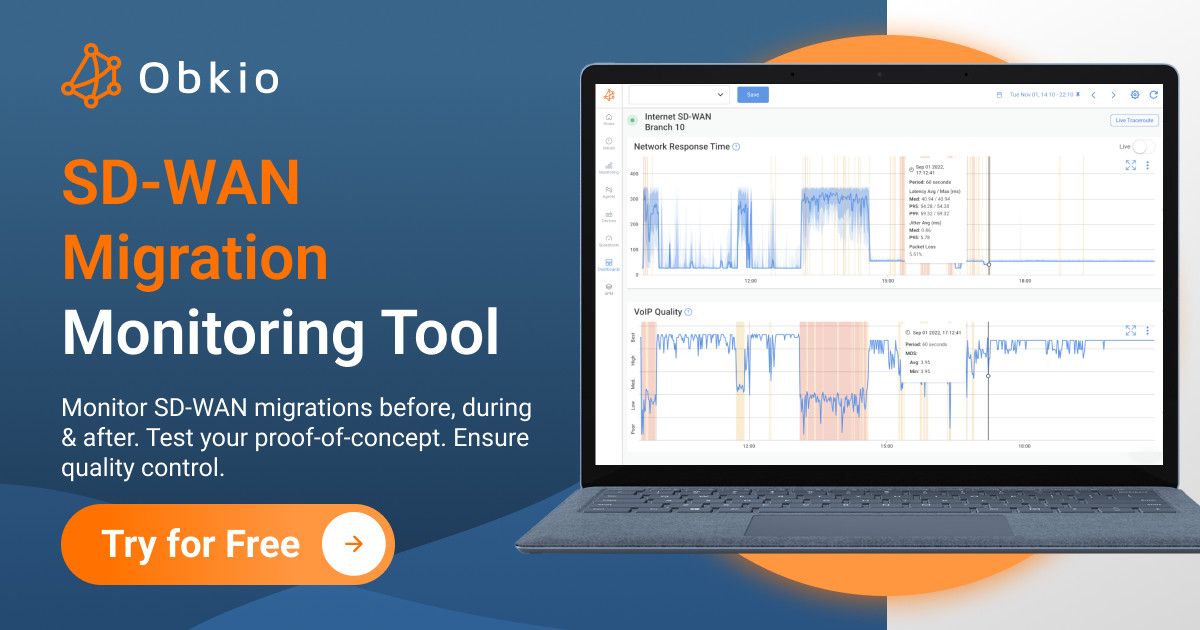Table of Contents
Table of Contents
In the fast-paced realm of modern networking, enterprises are constantly seeking innovative solutions to enhance their connectivity, security, and overall network performance. Software-Defined Wide Area Networking (SD-WAN) has emerged as a game-changer, providing organizations with the agility and flexibility required to meet their ever-evolving connectivity needs. However, implementing SD-WAN involves intricate migration processes that necessitate careful monitoring to ensure a smooth transition and maximize its benefits.
Monitoring SD-WAN migrations is one of the most common use cases for monitoring network performance. When taking on any new migration, it’s important to monitor network performance before, during, and after for complete network SD-WAN visibility.
In this blog post, we will delve into the intricacies of SD-WAN migrations and explore the crucial aspects of monitoring that are vital to the success of such transitions. Whether you are a network administrator, an IT professional, or a decision-maker contemplating an SD-WAN migration, understanding the monitoring techniques and best practices will empower you to navigate this transformational journey with confidence and achieve optimal results.
Keep reading to learn how to monitor SD-WAN migrations using Network Monitoring!
This article is part of a series of articles about continuously monitoring SD-WAN networks before, during, and after migrations. The articles include:
- How to Monitor SD-WAN Migrations (this article)
- How to Monitor MPLS to SD-WAN Migrations
- How to Monitor SD-WAN Networks
- SD-WAN Troubleshooting
- Common SD-WAN Issues
In today's highly interconnected world, organizations face a multitude of challenges when it comes to their network infrastructure. Traditional wide area networks (WANs) often struggle to keep up with the demands of modern business operations. This is where SD-WAN comes into play, offering a range of benefits and advantages that make it an attractive option for organizations considering a network migration. Let's explore some of these key benefits:
- Enhanced Network Performance: SD-WAN leverages multiple transport technologies, such as MPLS, broadband, 4G/5G, and satellite, to create a virtual network overlay. This allows organizations to optimize traffic routing dynamically based on application requirements and network conditions. By intelligently steering traffic across the most efficient paths, SD-WAN minimizes latency, packet loss, and congestion, resulting in improved network performance and a better end-user experience.
- Cost Savings: Traditional WAN architectures, relying heavily on expensive MPLS connections, can strain an organization's budget. SD-WAN provides the flexibility to leverage cost-effective broadband connections as an alternative or in combination with MPLS. This allows organizations to reduce their reliance on expensive dedicated circuits and achieve substantial cost savings while maintaining a reliable and secure network.
- Scalability and Agility: The ability to scale network resources quickly and efficiently is crucial in today's rapidly evolving business landscape. SD-WAN offers centralized management and control, simplifying network administration and enabling organizations to scale their network infrastructure with ease. Whether adding new branch offices, integrating cloud services, or accommodating increased bandwidth demands, SD-WAN provides the agility required to adapt to changing business requirements swiftly.
- Improved Application Performance: Applications are the lifeblood of modern organizations, and ensuring their optimal performance is paramount. SD-WAN's application-aware routing capabilities prioritize critical applications, such as real-time voice and video conferencing, ensuring low latency and a consistent user experience. By dynamically adjusting traffic flows, SD-WAN ensures that bandwidth-hungry applications do not hinder critical business processes, resulting in improved productivity and user satisfaction.
- Simplified Management and Automation: Traditional WAN architectures often involve complex configurations and manual processes, making network management cumbersome and time-consuming. SD-WAN simplifies network management through centralized orchestration and automation, allowing organizations to define policies, deploy network changes, and monitor performance from a single pane of glass. This simplification frees up IT resources, reduces human errors, and enables faster troubleshooting and problem resolution.
- Enhanced Security: SD-WAN introduces robust security features to protect the organization's network and data. It enables end-to-end encryption, ensuring secure communication across the WAN. Additionally, SD-WAN integrates advanced security functionalities, such as next-generation firewalls, intrusion detection and prevention systems, and secure web gateways. These capabilities provide granular control and visibility, protecting the network from evolving cyber threats and enhancing overall security posture.
- Cloud Readiness: As organizations increasingly adopt cloud-based applications and services, the network must be capable of efficiently and securely connecting users to these resources. SD-WAN provides direct and optimized access to cloud services, bypassing the traditional hairpinning of traffic through the data center. This reduces latency, improves performance, and enhances user experience, making SD-WAN an ideal solution for organizations embracing the cloud.
By migrating to SD-WAN, organizations can unlock a range of benefits that address the limitations of traditional WAN architectures.
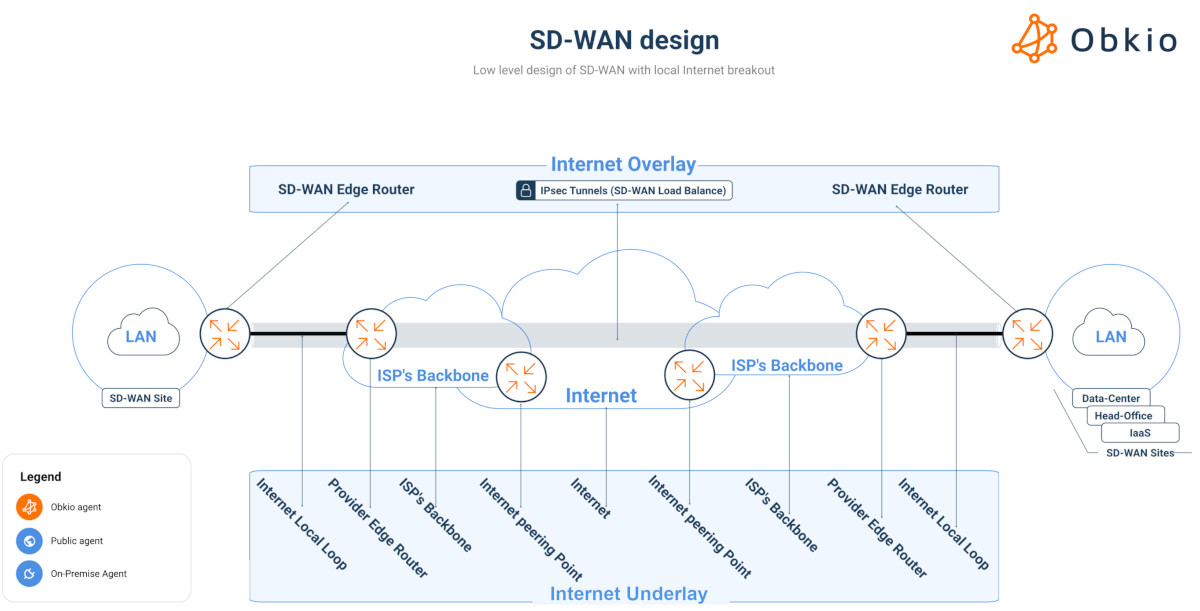
Ready to ride the wave of a seamless SD-WAN migration? Surf with confidence by monitoring your network performance using Obkio!
Catch every detail, ride the performance wave, and ensure a smooth transition. Don't leave your network to chance – dive in and make a splash with Obkio's powerful monitoring solution.

- 14-day free trial of all premium features
- Deploy in just 10 minutes
- Monitor performance in all key network locations
- Measure real-time network metrics
- Identify and troubleshoot live network problems

When embarking on the journey of SD-WAN migration, organizations have various paths to choose from based on their existing network infrastructure and goals. Each type of migration presents unique considerations and challenges. Let's delve into the key types of SD-WAN migrations that demand vigilant monitoring.
Here are some of the most common types of SD-WAN migrations:
- MPLS to SD-WAN Migration: Transitioning from expensive MPLS networks to SD-WAN that combines MPLS, broadband, and other transports, reducing costs while maintaining network performance and security.
- Hybrid WAN to SD-WAN Migration: Replacing or augmenting existing connectivity with SD-WAN devices, optimizing traffic flows, and gaining better network visibility and control in a hybrid network environment or Dual-WAN network.
- Internet VPN to SD-WAN Migration: Replacing site-to-site VPN connections with SD-WAN appliances, leveraging multiple transport technologies, improving network performance, and enhancing security and control.
- Legacy Router Refresh to SD-WAN Migration: Modernizing network infrastructure by replacing outdated branch routers with SD-WAN appliances, improving performance, security, and simplifying management.
- Cloud-based SD-WAN Migration: Deploying SD-WAN gateways or virtual instances in public cloud environments, establishing direct and optimized connections between branch offices and cloud resources, enhancing application performance, and ensuring a consistent user experience.
These are just a few examples of the most common types of SD-WAN migrations. The specific migration path chosen by an organization depends on their existing network infrastructure, business requirements, and desired outcomes.
Explore the gladiators of WAN, MPLS vs. SD-WAN, strengths, weaknesses & ideal uses. Decide if SD-WAN networks or MPLS networks are right for your business.
Learn more

Businesses are increasingly moving to cloud-based applications, which increases our reliance on the Internet to deliver WAN traffic. As a result, many businesses are migrating from MPLS networks to hybrid WAN architectures and SD-WAN technology.
One mistake that businesses make when taking on an SD-WAN migration is lacking SD-WAN visibility over their SD-WAN service.
Here's a closer look at the key aspects of monitoring in SD-WAN migrations:
Monitoring plays a crucial role in the pre-migration phase of an SD-WAN deployment. It allows organizations to assess the current network infrastructure, understand application dependencies, and identify performance bottlenecks. By gathering data on network traffic, latency, packet loss, and application response times, organizations can establish a network baseline of performance in the existing network environment. This baseline helps in identifying areas that need improvement and serves as a reference point for evaluating the impact of the SD-WAN migration on network performance.
During the SD-WAN migration process, monitoring becomes instrumental in ensuring a smooth transition from the legacy network to the SD-WAN environment. Real-time monitoring provides visibility into network traffic, application performance, and security metrics, allowing organizations to track the progress of the SD-WAN migration and identify any issues or bottlenecks. It enables proactive troubleshooting, minimizing disruptions and ensuring a successful migration. By closely monitoring key performance indicators (KPIs), organizations can validate that the migration is proceeding as planned and make necessary adjustments if required.
Monitoring continues to play a crucial role in optimizing the performance of the SD-WAN network post-migration. It provides ongoing visibility into network performance metrics such as bandwidth utilization, latency, jitter, and packet loss. By monitoring these metrics, organizations can identify any performance issues, congestion points, or network bottlenecks. This information helps in optimizing traffic routing, adjusting Quality of Service (QoS) policies, and making configuration changes to ensure optimal performance and a seamless user experience.
SLA Monitoring is a critical component of SD-WAN migrations. Organizations need to ensure that the agreed-upon service levels are being met or exceeded in the new SD-WAN environment. By monitoring SLA metrics such as network availability, latency, packet loss, and jitter, organizations can proactively identify and address any performance issues that may impact SLA compliance. This allows organizations to maintain high service quality, meet customer expectations, and uphold contractual obligations.
Most solutions can’t offer the depth and detail needed for monitoring SD-WAN networks, and also don’t monitor from the end-user perspective - which is extremely important for understanding if your SD-WAN migration is providing the service quality that was promised.
That's where end-to-end Network Monitoring comes in.
For the detail and depth you need to monitor your SD-WAN migrations, it is crucial to have an end-to-end network monitoring solution in place. Traditional monitoring solutions that only focus on individual network devices cannot provide the comprehensive insight required to monitor the performance of your SD-WAN environment.
An end-to-end network monitoring solution, such as Obkio Network Performance Monitoring tool, offers several advantages for monitoring your SD-WAN migration. It enables you to identify network problems before and after the migration, ensuring a smooth transition and optimal performance.
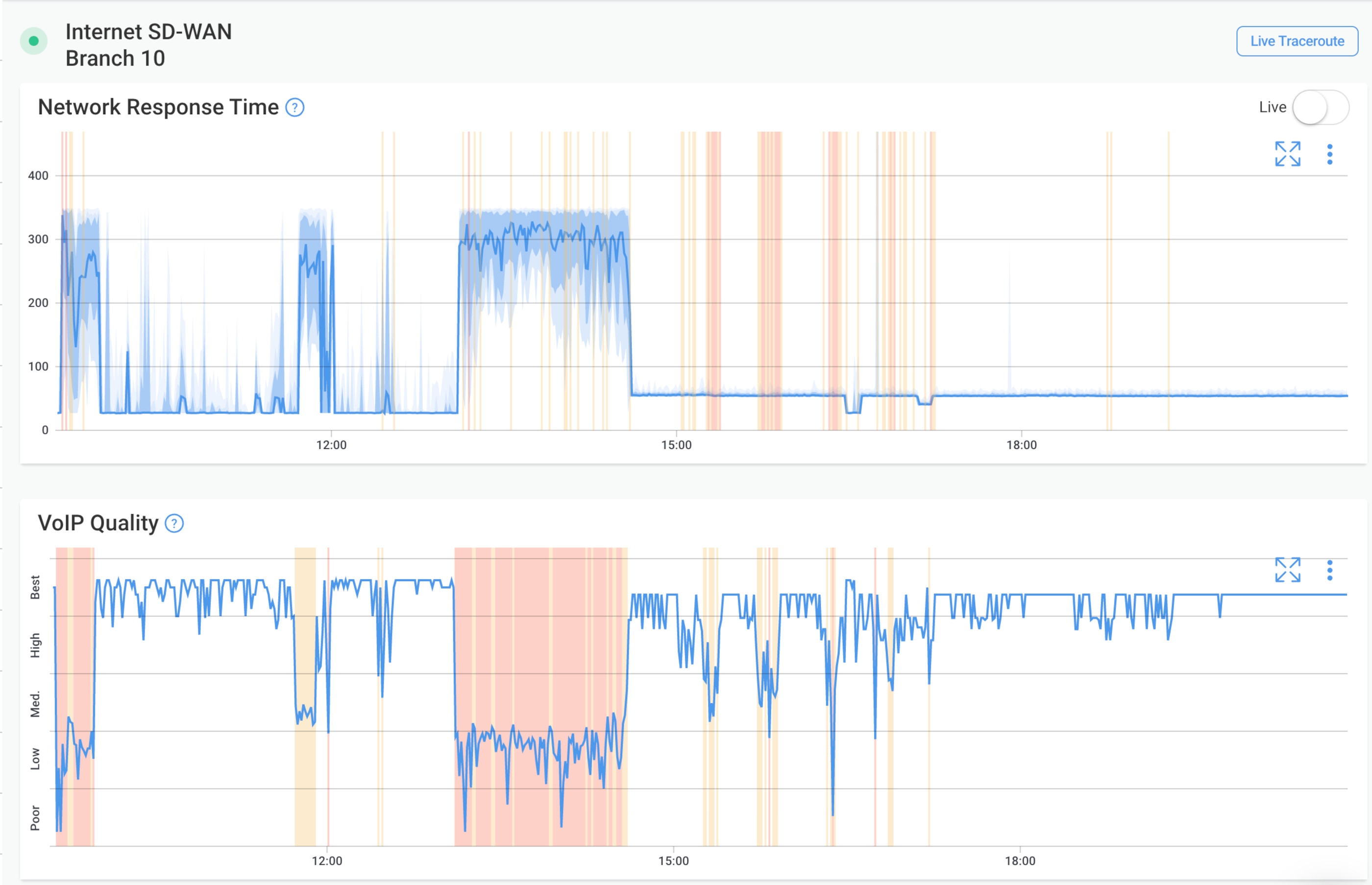
Unlike traditional monitoring solutions that focus on individual network devices, Obkio offers end-to-end performance monitoring. It assesses the performance of your network from the user's perspective, taking into account the entire network path, including branch offices, data centers, and cloud environments. This comprehensive view enables you to identify performance bottlenecks and troubleshoot issues across the entire SD-WAN infrastructure.
Deploy Obkio before your SD-WAN migration now!

We always talk about the importance of implementing network monitoring before your SD-WAN migration, but why is that?
- Baseline Performance Assessment: Obkio establishes a performance baseline for your existing network, serving as a reference point during the migration.
- Pre-Migration Issue Identification: Obkio helps detect and address network issues before the migration, ensuring a smoother transition.
- Optimal SD-WAN Design and Planning: Obkio provides critical network performance data for designing an effective SD-WAN architecture.
- Proactive Performance Monitoring: Obkio enables real-time monitoring during the migration, allowing for prompt issue resolution and minimal disruptions.
- Seamless Transition and User Experience: Obkio ensures a seamless migration experience by validating that the new SD-WAN meets performance expectations.
A tool like Obkio Network Performance Monitoring software continuously monitors end-to-end network performance with synthetic traffic using Network Monitoring Agents.
These Monitoring Agents monitor network performance from the source (your computer or your office) up to the destination (another office, datacenter or clouds) to identify and troubleshoot network problems affecting your network before and after your SD-WAN migration.
When performing an SD-WAN migration, it’s important to deploy your monitoring solution before the migration so you can compare the performance before and after the migration.
To monitor network performance prior to your SD-WAN migration, we recommend deploying Monitoring Agents with sessions in:
- Your Local Network
- And between network locations: remote offices and your company’s headquarters, data centers or clouds
In the example below, a local monitoring agent in a branch office has a monitoring session towards a monitoring agent located in a data center.
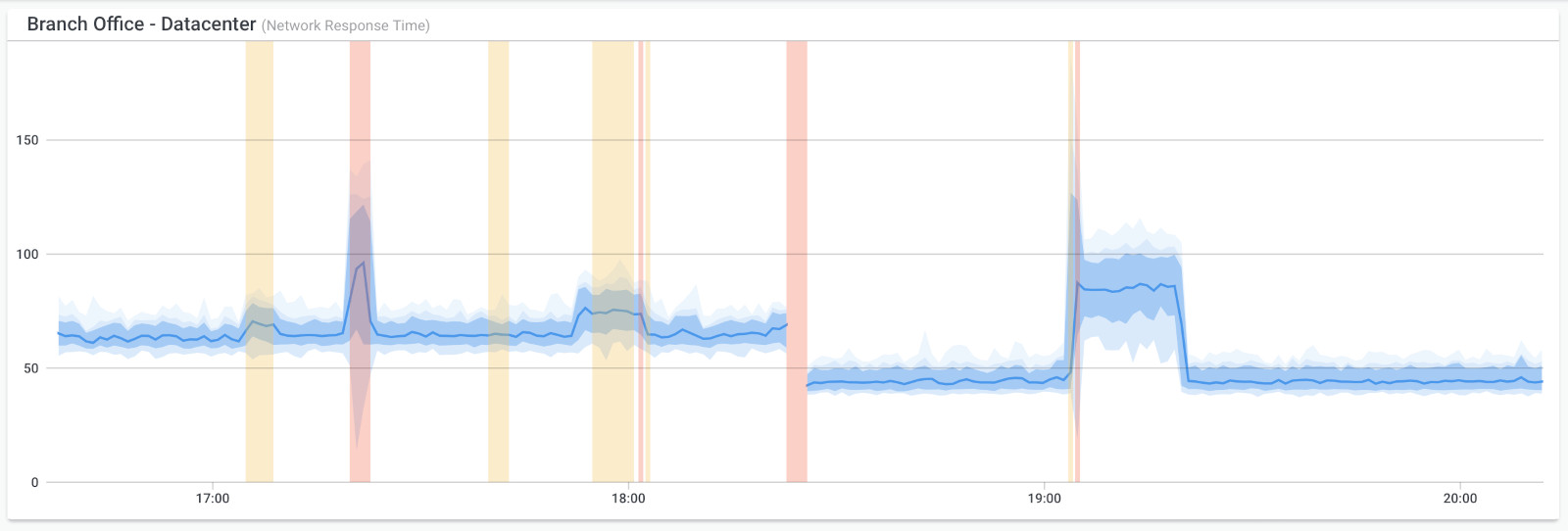
In this example, the branch office migrated from a dedicated low-bandwidth MPLS connection to an SD-WAN service with two brandband connections.
- The migration occurred in the middle of the graph (around 18:20).
- A few minutes later, around 19:00, the SD-WAN service switched from the primary ISP to the secondary ISP due to high packet loss for about 15 minutes.
- There is just a little bit of packet loss during the network failover because it took a few seconds for the SD-WAN appliance to failover.
Pro-Tip: A similar setup can also be used to monitor SASE networks.
With Obkio in place before the SD-WAN migration, you can continuously monitor the network performance during the migration process. This real-time monitoring enables you to detect any performance degradation, anomalies, or connectivity issues that arise during the transition.
By closely monitoring the network, you can proactively address any emerging challenges, troubleshoot issues promptly, and ensure a seamless migration experience for end-users. This proactive approach minimizes disruptions, reduces downtime, and helps you maintain service levels throughout the migration.
During your SD-WAN migration, it is essential to measure various network metrics to ensure a successful transition. Here are some important network metrics that you should measure:
- Latency: Latency refers to the time it takes for data packets to travel from the source to the destination. Measuring latency helps you assess the responsiveness of your network. During the migration, monitor latency to ensure that the SD-WAN solution maintains or improves latency compared to the legacy network.
- Packet Loss: Packet loss occurs when data packets are dropped or fail to reach their destination. Monitoring packet loss is crucial to identify any issues with network reliability and performance. It helps you ensure that the SD-WAN migration does not introduce significant packet loss and impacts application performance.
- Jitter: Jitter is the variation in delay for packet delivery, often resulting in irregularities in the timing of packet arrivals. Monitoring jitter is important as it can impact the quality of real-time applications such as VoIP or video conferencing. Ensure that the SD-WAN solution effectively manages and minimizes jitter during the migration.
- Bandwidth Utilization: Monitoring bandwidth utilization allows you to track the amount of network capacity being used at any given time. It helps you identify any spikes or congestion points during the migration. Measuring bandwidth utilization assists in network capacity planning and ensuring that the SD-WAN solution effectively utilizes available bandwidth.
- Application Performance: Monitoring the performance of critical applications is essential during the migration. Measure application response times, throughput, and transaction success rates to ensure that the SD-WAN solution maintains or improves application performance compared to the legacy network. This helps you identify any performance degradation or bottlenecks that need attention.
- Network Availability: Network availability measures the percentage of time that the network is accessible and operational. It is crucial to monitor network availability during the migration to ensure minimal network downtime and a smooth transition. Measure the availability of the SD-WAN solution and compare it to the availability of the legacy network.
- Quality of Service (QoS): QoS metrics assess the performance levels of different traffic types or classes within the network. Monitor QoS metrics to ensure that the SD-WAN solution effectively prioritizes and delivers critical applications with the expected level of performance and meets the defined QoS policies.
By measuring these network metrics during your SD-WAN migration, you can assess the performance, reliability, and security aspects of the new network infrastructure. It helps you identify any areas that require optimization, troubleshooting, or configuration adjustments to ensure a successful migration with improved network performance.
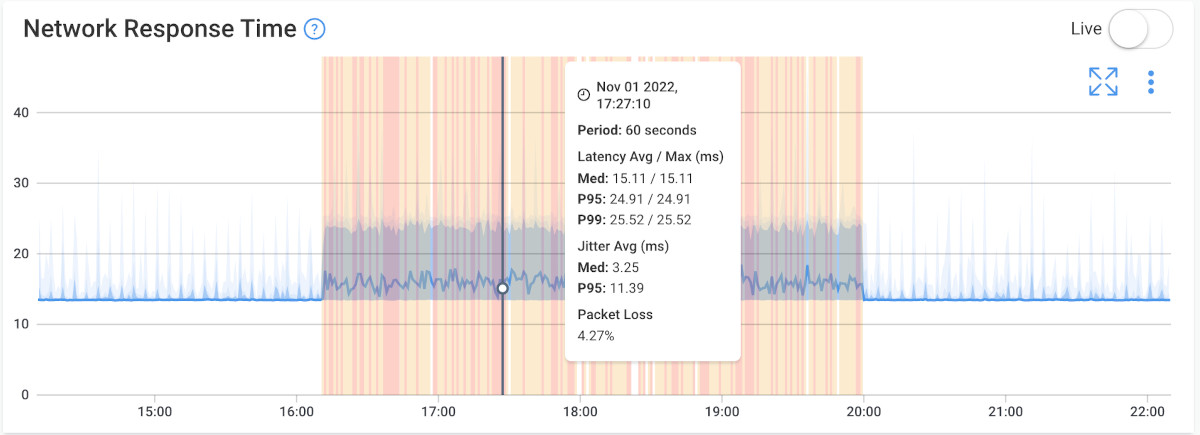
Obkio's monitoring capabilities enable you to identify any pre-existing network issues or bottlenecks before initiating the SD-WAN migration. By monitoring the network continuously, you can detect and address performance problems, congestion points, or potential connectivity issues that may impact the migration process. Identifying and resolving these issues beforehand ensures a smoother transition and minimizes disruptions during the migration.
During an SD-WAN migration, several network issues or bottlenecks can affect the smooth transition and optimal performance of the new network infrastructure. Here are some common network issues and bottlenecks to be aware of:
- Insufficient Bandwidth: Inadequate bandwidth can lead to congestion and performance degradation during the migration. If the SD-WAN solution does not have sufficient bandwidth capacity to handle the traffic demands, it can result in reduced application performance and user experience.
- Network Latency: High network latency can impact the responsiveness of applications and user interactions. Latency issues can arise due to long network paths, inefficient routing, or suboptimal network configurations. If latency is not effectively managed in the SD-WAN environment, it can hinder the migration process and affect application performance.
- Packet Loss: Packet loss can occur when packets are dropped or fail to reach their destination. It can result from network congestion, misconfigurations, or quality issues in the network links. Packet loss impacts the reliability and integrity of data transmissions, leading to degraded application performance and potential data loss during the migration.
- Jitter: Jitter refers to variations in the delay of packet delivery, causing irregularities in packet arrival times. High jitter can affect real-time applications, such as VoIP or video conferencing, causing audio or video disruptions. If not properly managed in the SD-WAN environment, jitter can introduce inconsistencies and affect the migration process.
- Suboptimal Routing: Inefficient routing can lead to suboptimal traffic paths and increased latency. If the SD-WAN solution does not dynamically select the best available path based on network conditions, traffic may be routed through congested or unreliable links, impacting application performance and migration efficiency.
- Application Compatibility: Certain applications may not be fully compatible with the SD-WAN solution or may require specific configurations or optimizations. If application compatibility issues arise during the migration, it can impact their functionality, performance, and integration with the new network environment.
- Lack of Visibility and Monitoring: Inadequate visibility and monitoring capabilities can make it challenging to identify and address network issues during the migration. Without real-time monitoring and analytics, it becomes difficult to pinpoint the root causes of performance degradation or security incidents, delaying troubleshooting and resolution efforts.
By being aware of these network issues and bottlenecks, organizations can proactively plan, design, and optimize their SD-WAN migration to mitigate these challenges. Proper network assessment, network testing, and continuous monitoring during the migration process are crucial to identify and resolve any issues promptly, ensuring a successful and seamless transition to the SD-WAN environment.
With Obkio, you can set up network monitoring alerts and notifications based on predefined thresholds for performance metrics. This enables proactive issue detection, allowing you to take immediate action when deviations from expected performance occur. By identifying potential problems early on, you can mitigate the impact on your SD-WAN migration and ensure a smooth and successful transition.


After the SD-WAN migration, Obkio continues to monitor the network performance in the new environment. It provides real-time visibility into key performance metrics such as latency, packet loss, and application response times. By comparing these metrics with the baseline data, you can assess the impact of the migration on network performance.
Obkio's performance monitoring capabilities enable you to compare the performance before and after the migration. If the SD-WAN migration is successful, you should observe improvements in key metrics such as reduced latency, lower packet loss, and enhanced application response times. Comparing the performance data allows you to quantify the improvements achieved through the migration.
Comparing historical performance data is key to understanding the effect of the SD-WAN migration on your network.
Obkio also measures and collects historical network performance data, so you can analyze, compare, and troubleshoot performance from the past and compare performance before your SD-WAN migration and after.
Analyzing historical data allows you to go back in time to identify intermittent network problems that may look like they disappeared.
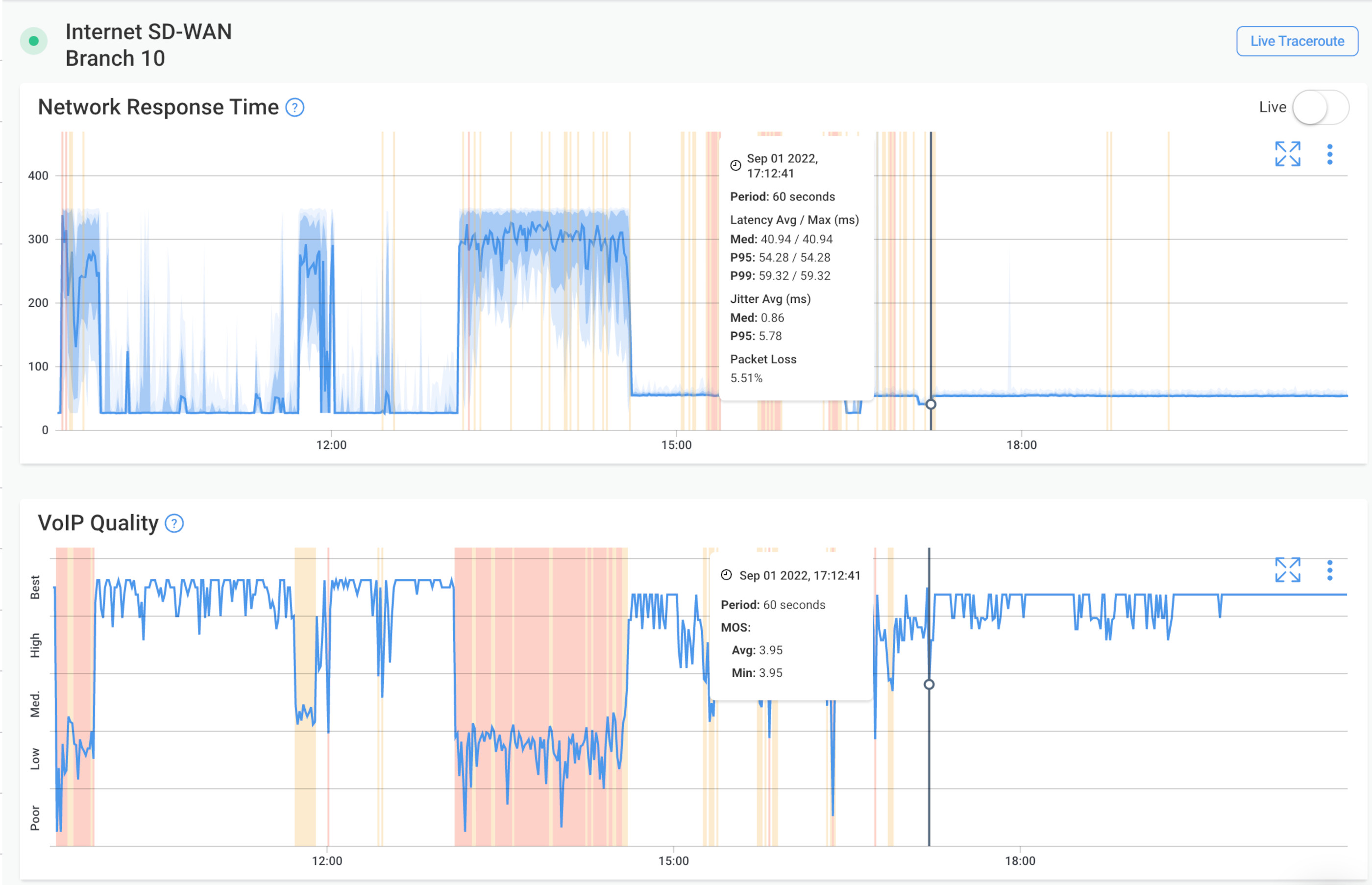
Obkio's Network Performance Monitoring software offers comprehensive reporting and analysis capabilities. It generates detailed reports on network performance, allowing you to gain insights into trends, historical data, and areas of improvement. These reports help you evaluate the success of your SD-WAN migration, track key performance indicators, and make data-driven decisions to optimize your network's performance.
After your SD-WAN migration, continue to monitor performance from the end-user perspective, as well as the underlay connections themselves, to see how your new SD-WAN service is performing.
You can then collect data to identify network problems related to your SD-WAN migration and collect the information you’ll use to troubleshoot network issues with Obkio’s key troubleshooting tools.
You can learn more about that in our next article of the series on How to Monitor SD-WAN Networks.
Learn how to monitor SD-WAN networks with Network Monitoring to get complete visibility over your SD-WAN service and identify SD-WAN issues.
Learn more

- Real-time Performance Monitoring: Obkio provides real-time monitoring of key performance metrics, including latency, packet loss, jitter, and application response times. By continuously monitoring these metrics, you can assess the performance of your SD-WAN environment and ensure that it meets the desired service levels. Real-time monitoring allows you to proactively identify and address any performance issues that may arise after the migration.
- Traffic Path Analysis: With Obkio, you can analyze the path taken by your network traffic within the SD-WAN infrastructure. This visibility helps you understand how traffic is being routed and whether it follows the intended paths. By monitoring traffic paths, you can identify any suboptimal routing or misconfigurations that may affect performance. Adjusting the routing accordingly can lead to better network performance and enhanced user experience.
- Proactive Issue Detection: Obkio's monitoring capabilities enable you to proactively detect and troubleshoot any performance issues that arise in the SD-WAN environment. By setting up alerts and notifications based on predefined thresholds, you can receive instant notifications when performance metrics deviate from normal levels. This allows you to take prompt action, investigate the underlying causes, and resolve the issues before they impact end-user experience.
- Historical Performance Analysis: Obkio stores historical performance data, allowing you to analyze performance trends over time. By comparing current performance with historical data, you can identify any changes or deviations in network performance. This analysis helps in understanding long-term performance patterns, detecting potential degradation, and planning for future optimizations or capacity upgrades.
- Capacity Planning and Optimization: With Obkio, you can monitor bandwidth utilization and track network capacity to ensure efficient resource allocation. By analyzing bandwidth usage trends, you can identify potential capacity constraints and plan for future growth or optimization. This helps in making informed decisions about bandwidth provisioning, QoS policies, and network upgrades to maintain optimal performance in the SD-WAN environment.
- SLA Monitoring: Obkio allows you to monitor the performance of your SD-WAN environment against defined Service Level Agreements (SLAs). By tracking performance metrics and comparing them to SLA targets, you can ensure compliance and hold service providers accountable for delivering the agreed-upon performance levels.
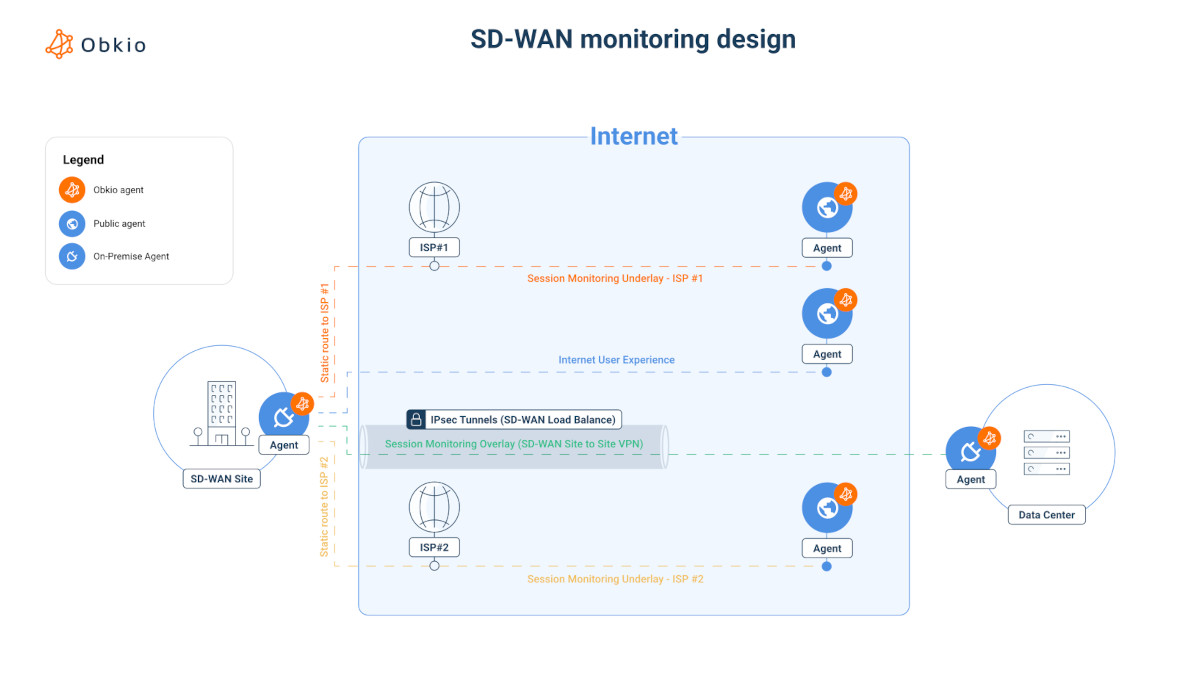

Now that you know how to monitor your SD-WAN migration, we wanted to leave you with the ultimate checklist to plan your SD-WAN migration that summarizes a lot of the points we discussed in this article!
A successful SD-WAN migration requires careful planning and preparation to ensure a smooth transition from the existing network infrastructure to the new SD-WAN environment. This phase is crucial as it sets the foundation for a seamless migration process.
Here are key considerations to focus on during the planning and preparation stage:
Before initiating the migration, it is essential to assess the current network infrastructure comprehensively. This network assessment involves evaluating the existing WAN topology, connectivity options, bandwidth requirements, and performance limitations. By understanding the strengths and weaknesses of the current infrastructure, organizations can make informed decisions regarding SD-WAN deployment and configuration.
A well-defined migration strategy is vital to ensure a smooth transition. This strategy should outline the step-by-step approach for deploying SD-WAN across the organization's branch offices and data centers. It should include considerations such as the sequence of migration, pilot site selection, deployment timelines, and the allocation of necessary resources. Developing a comprehensive migration strategy ensures that all stakeholders are aligned and aware of the objectives and timelines associated with the migration.
A crucial aspect of a successful SD-WAN migration is the implementation of a robust monitoring solution. Monitoring plays a pivotal role in ensuring the smooth operation of both the migration process itself and the SD-WAN network after the migration is complete. Implementing a comprehensive SD-WAN monitoring solution involves deploying monitoring tools and establishing monitoring processes that provide visibility into the network infrastructure, application performance, security, and overall health of the SD-WAN environment.
Implementing an SD-WAN monitoring solution before the migration is essential for several reasons. First, it allows organizations to establish a baseline of network performance and application behavior in the existing network environment. By gathering data on traffic patterns, latency, packet loss, and application response times, organizations can understand the performance characteristics and bottlenecks of their current network. This baseline serves as a reference point for assessing the impact of the migration on network performance and enables effective troubleshooting during the migration process.
Furthermore, monitoring before the migration provides valuable insights into application dependencies, bandwidth requirements, and network traffic flows. This information helps in designing appropriate QoS policies, traffic steering rules, and security measures in the SD-WAN environment. By understanding the specific needs of applications and user groups, organizations can optimize the SD-WAN configuration and ensure a seamless migration experience for end-users.
Implementing an SD-WAN monitoring solution during the migration is crucial for tracking the progress of the migration process. Real-time monitoring allows organizations to identify any issues, bottlenecks, or performance degradation during the transition from the legacy network to the SD-WAN environment. By closely monitoring network traffic, application performance, and security metrics, organizations can proactively address any challenges that arise, minimize disruptions, and ensure a successful migration.
Once the migration is complete, ongoing monitoring of the SD-WAN network becomes indispensable for maintaining optimal performance and identifying potential issues. A comprehensive monitoring solution provides visibility into key performance indicators (KPIs) such as bandwidth utilization, latency, jitter, packet loss, and application response times. It allows organizations to proactively detect anomalies, troubleshoot network issues, and ensure that the SD-WAN environment operates at its full potential.
In addition to performance monitoring, implementing a robust security monitoring component is vital to safeguard the SD-WAN network against threats and vulnerabilities. Security monitoring helps detect and mitigate potential cyber threats, unauthorized access attempts, and anomalous network behavior. By continuously monitoring security events and leveraging real-time analytics, organizations can enhance their overall security posture and protect critical data and applications.
During the migration process, there is often a period of coexistence where the legacy network infrastructure and the new SD-WAN solution operate simultaneously. It is crucial to establish interoperability between the two systems to maintain business continuity and minimize disruptions. This involves ensuring that the SD-WAN solution can seamlessly integrate with existing routers, switches, and security appliances. By planning for a smooth coexistence phase, organizations can avoid service interruptions and ensure a gradual and controlled migration process.
As part of the planning phase, organizations should identify the critical applications and services that require prioritization and Quality of Service (QoS) policies. Understanding the specific requirements of these applications enables organizations to optimize traffic routing and allocation of network resources in the SD-WAN environment. By assigning appropriate QoS policies, organizations can use network optimization ensure that mission-critical applications receive the necessary bandwidth and performance, enhancing the overall user experience.
Security is a paramount consideration during any network migration. Organizations must assess the security requirements specific to their industry and ensure that the SD-WAN solution meets those requirements. This involves evaluating encryption capabilities, authentication mechanisms, firewall integration, and compliance with regulatory standards. By addressing security concerns during the planning phase, organizations can maintain a strong security posture throughout the migration process.
Migrating to SD-WAN often requires a change in processes, workflows, and IT management practices. It is crucial to provide comprehensive training to IT staff and network administrators on the new SD-WAN solution, its features, and its management interface. Training sessions should cover topics such as provisioning, monitoring, troubleshooting, and security practices specific to the SD-WAN environment. Additionally, organizations should develop a change management plan to effectively communicate the migration process, manage expectations, and address any concerns from end-users or stakeholders.
By investing time and effort into planning and preparation, organizations can ensure a smooth and successful SD-WAN migration. This phase sets the stage for a seamless transition, minimizes disruptions, and maximizes the benefits of SD-WAN implementation.


Are you planning a migration to a new SD-WAN network?
SD-WAN migration monitoring using Network Monitoring is an essential risk management tool and should be performed to qualify your network for your SD-WAN migration, as well as to gain SD-WAN visibility and monitor changes in performance after.
Remember, after your migration, keep continuously monitoring your SD-WAN network with Obkio's SD-WAN Monitoring tool to proactively identify network problems and performance issues!
Uncover hidden bottlenecks, conquer latency waves, and sail smoothly into the world of enhanced performance. Don't let your SD-WAN migration drift aimlessly – set sail with Obkio's monitoring solution and chart a course towards network success

- 14-day free trial of all premium features
- Deploy in just 10 minutes
- Monitor performance in all key network locations
- Measure real-time network metrics
- Identify and troubleshoot live network problems



























 Obkio Blog
Obkio Blog






